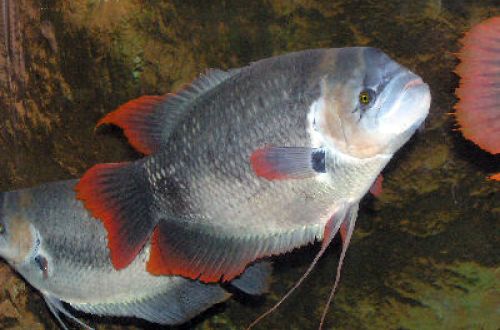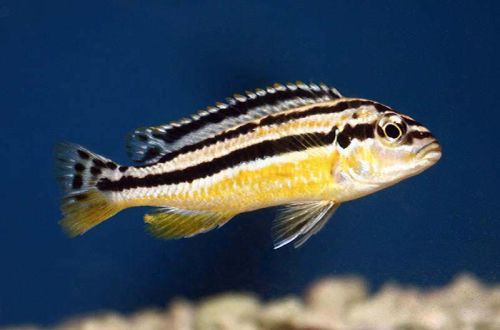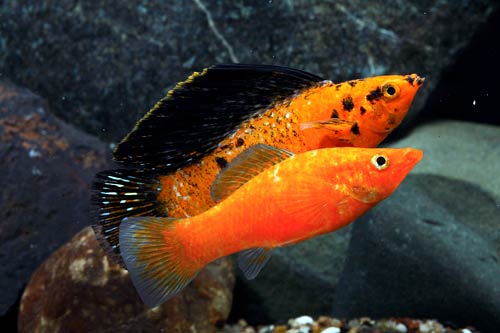
Molliesia velifer
Velifera mollies, scientific name Poecilia velifera, belongs to the family Poeciliidae (pecilia or gambusia). In relation to this species, another name is often used – the Giant Molly sailboat.

Contents
Habitat
The fish is native to Central and partly South America. The natural range extends from Mexico to Colombia, although it was originally endemic to the Yucatan Peninsula. The fish inhabits numerous rivers flowing into the Caribbean Sea, including mouths with brackish water. It is currently found in the Middle East, Southeast Asia, Australia and New Zealand, where it appears to have entered from home aquaria as an invasive species.
Description
The fish has a closely related species Mollies latipin, no less popular in the aquarium hobby. Juveniles of both species are practically indistinguishable and are identified only by the number of rays in the dorsal fin. The first has 18–19 of them, the second has only 14. In adults, more pronounced differences are observed. Velifera mollies are noticeably larger. Females reach a length of up to 17 cm. Males are smaller (up to 15 cm) and, unlike females, have a more massive dorsal fin, for which they got their name “Sailboat”.
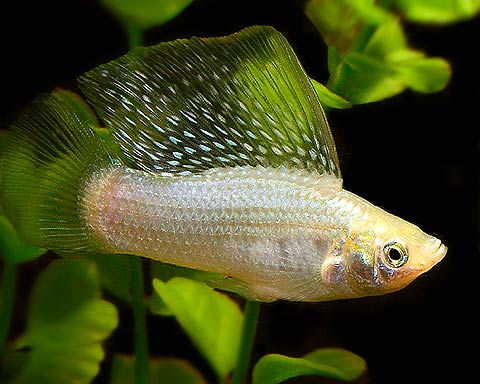
The initial coloration is gray with a pattern of dotted horizontal lines. However, in recent years, many hybrid varieties have been bred that have acquired a variety of colors and shades. The most popular are plain yellow, orange, black, white (albino) and several variegated forms.
Brief information:
- The volume of the aquarium is from 80–100 liters.
- Temperature – 22-28°C
- Value pH — 7.0–8.5
- Water hardness – medium to high hardness (15-35 GH)
- Substrate type – any
- Lighting – any
- Brackish water – no
- Water movement is weak
- The size of the fish is 15–17 cm.
- Food – any food
- Temperament – peaceful
- Content alone, in pairs or in a group
Food
Accepts most popular foods in the aquarium trade in dry, frozen and live form. The diet should include a certain amount of herbal ingredients. If they are already present in dry flakes and granules, then, for example, bloodworms, artemia will need to add spirulina flakes or similar products.
Maintenance and care, arrangement of the aquarium
The optimal size of the aquarium for one or two fish starts from 80-100 liters. The design uses a large number of rooting and floating aquatic vegetation while maintaining free areas for swimming. At the same time, excessive overgrowing should not be allowed, since it will be problematic for males with their sail fins to make their way through dense thickets. The lower tier (bottom) is not significant.
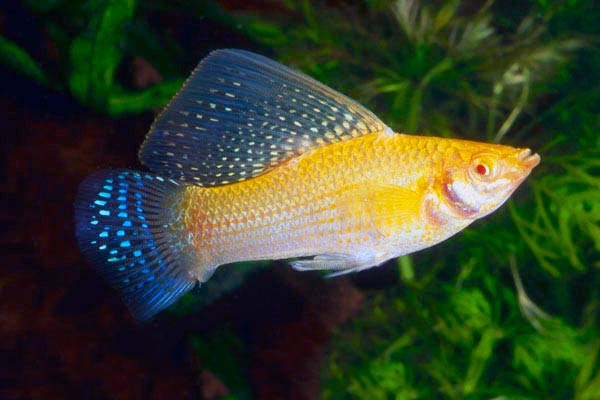
Viviparous species are usually easy to keep, but in the case of Velifera Molliesia, the situation is somewhat different. The fish needs sufficiently alkaline water with high carbonate hardness. It can live in brackish environments with a salt concentration of about 5 grams per liter. Soft slightly acidic water adversely affects the well-being of this species. It is the maintenance of the desired hydrochemical composition that will be the main difficulty in maintaining. Otherwise, the maintenance of the aquarium is standard and includes a number of mandatory procedures, such as weekly replacement of part of the water with fresh water while removing organic waste (food leftovers, excrement), equipment maintenance.
Behavior and Compatibility
It has a calm peaceful disposition. Could make a neighborhood for other freshwater fish, but the need for high pH and GH limits the number of compatible species. You can choose fish that can live in an alkaline environment on our website using a filter.
Breeding / breeding
Males are very temperamental during the mating season, therefore, with limited space, it is desirable to reduce the number of males to a minimum, for example, one male for 2–3 females. The incubation period, like in all livebearers, occurs inside the body without the formation of masonry with eggs. Pregnancy of females lasts on average from 4 to 8 weeks. Up to a couple of hundred fry can appear at a time, but usually the number is limited to 40-60. It is advisable to transplant the juveniles into a separate tank in order to avoid predation by their parents and other fish. Feed with specialized powdered feed, suspensions, Artemia nauplii.
It is worth remembering that it can produce hybrid offspring with Latipin Molliesia.
Fish diseases
In a favorable habitat, if the fish is not attacked and receives a balanced diet, then the risk of disease is minimal. It is sensitive to the hydrochemical composition of water, as noted above, low pH and GH values have a depressing effect on the fish organism, and manifestations of fungal and bacterial diseases are possible. Normalization of the habitat allows the immune system to cope with the problem, but if the disease progresses, then drug treatment is indispensable. Read more in the section “Diseases of aquarium fish”.



